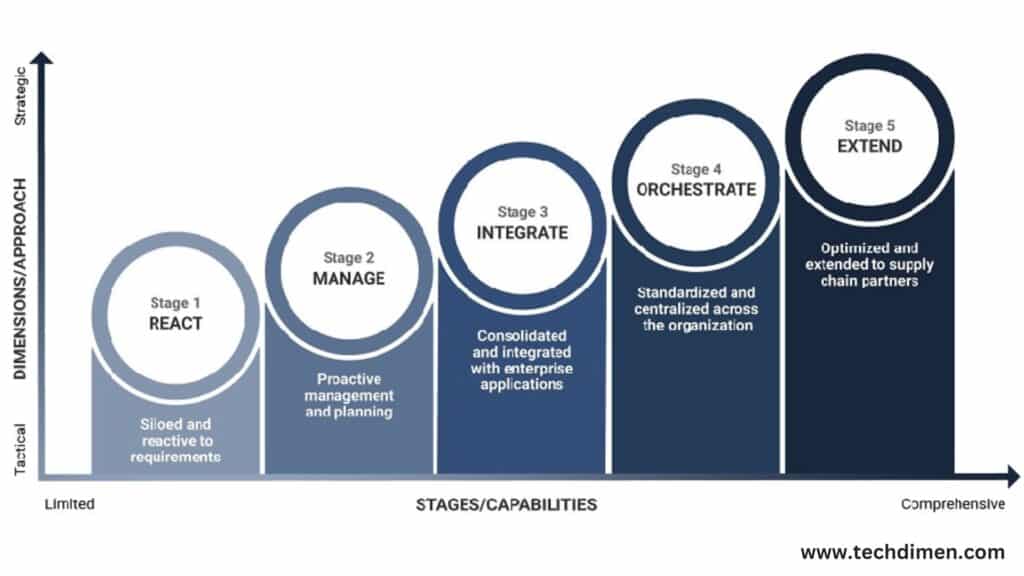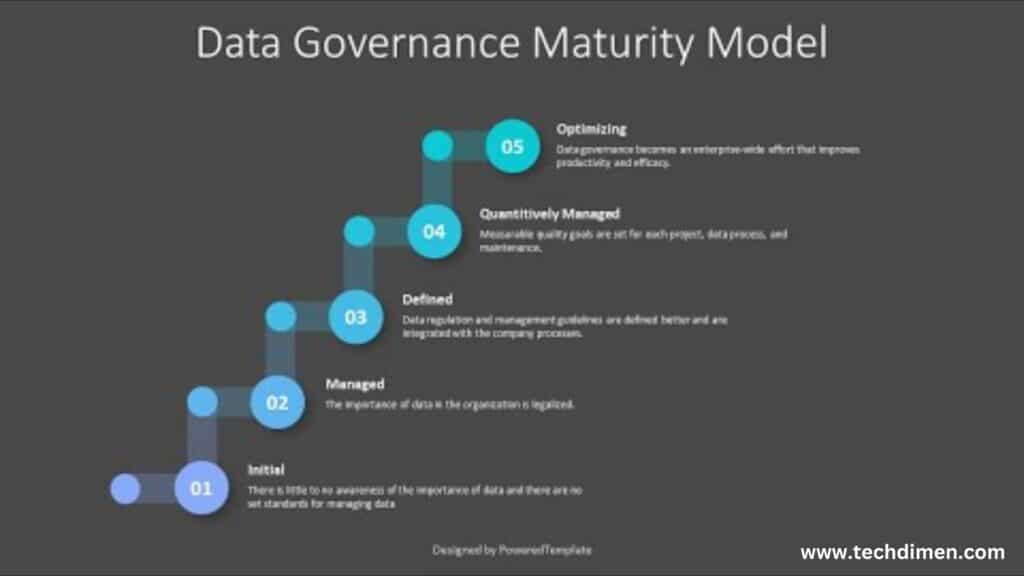In a rapidly evolving digital world, staying relevant means more than just keeping up it means leading the charge. But how do organizations know if their tech capabilities are truly ready to meet business demands? That’s where the Technology Maturity Model comes into play. This strategic framework provides a structured path for assessing, managing, and improving how your business integrates technology. Whether you’re just starting to digitize or aiming to become an AI-driven enterprise, understanding your position in the maturity journey is essential.
the Technology Maturity Model
The Technology Maturity Model sometimes referred to as the Tech Maturity Model, is a structured way to evaluate an organization’s technological capabilities across different dimensions. It helps companies gauge their level of digital capability, operational alignment, and readiness for future growth.
This model is not about assigning grades. Instead, it acts as a mirror, reflecting how effectively your systems, infrastructure, and teams work together. At its core, it’s a maturity model framework built on years of research into organizational behavior, technology transformation, and digital first strategies.
When organizations apply this model, they are better equipped to prioritize IT investments, reduce inefficiencies, strengthen cybersecurity, and create a more agile workforce.
Why Technology Maturity Matters in 2025

In today’s business landscape, digital transformation is no longer optional. The maturity level of your technology stack determines how quickly you can adapt to market changes, satisfy customer expectations, and outperform competitors.
A company with a low IT maturity stage may still rely on outdated systems, lack integration, and make decisions based on gut feelings instead of real-time data. On the flip side, a digitally mature organization operates with predictive analytics, integrates AI and automation into workflows, and makes faster, data-driven decisions that impact growth.
By understanding your technology maturity level, you gain a clear path forward. This clarity is crucial for businesses developing a digital transformation roadmap or seeking a formal digital maturity assessment.
The Five Stages of Technology Maturity

The journey toward technological excellence typically unfolds across five key stages. These stages represent increasing levels of IT capability maturity, strategic alignment, and technological sophistication.
At the first stage, known as the Initial or Ad Hoc stage, technology use is unstructured and inconsistent. There is little to no standardization, and systems are often patched together as needed. Innovation is rare, and problem-solving relies heavily on individual heroics rather than systemized processes.
In the Developing stage, some standards and tools start to emerge, but technology investments are still mostly reactive. Systems are fragmented, data is often siloed, and there’s a clear lack of cross departmental collaboration. Efforts toward business process automation may begin, but adoption is uneven.
As organizations move into the Defined stage, they begin aligning technology with broader business objectives. Processes are now documented and repeatable, and there’s greater use of performance metrics and dashboards. This stage often includes the early phases of DevOps adoption and cloud adoption maturity initiatives.
By the time a business reaches the Managed stage, systems are integrated, cybersecurity is proactive, and real-time data utilization plays a central role in decision-making. The organization begins demonstrating significant organizational agility, making it responsive to external and internal shifts.
Finally, the Optimized stage is where continuous improvement becomes part of the culture. Here, AI and intelligent automation are fully integrated into operations. Teams experiment, iterate, and use predictive analytics to anticipate trends. The company exhibits a clear commitment to being a digital first organization.
Technology Maturity Model Table
Here’s a simplified comparison showing how each stage stacks up in terms of strategy, investment, and agility:
| Maturity Stage | Organizational Characteristics | Tech Investment Focus | Agility Level |
|---|---|---|---|
| Initial | Uncoordinated, reactive, person-dependent | Minimal and unstructured | Low |
| Developing | Emerging processes, limited alignment | Tactical, fragmented | Medium-Low |
| Defined | Documented systems, goal-oriented IT | Aligned with business needs | Medium |
| Managed | Integrated, analytics-driven, secure | Strategic and scalable | High |
| Optimized | Innovative, AI-powered, continuously improving | Innovation-focused | Very High |
Assessing Your Current Maturity Level

To begin your journey, you first need to know where you stand. A digital maturity assessment gives insight into your organization’s strengths and gaps across areas like infrastructure, talent, data, governance, and innovation.
Ask yourself if processes are consistently documented. Consider how technology decisions are made and whether they align with your company’s vision. Think about your current state of IT infrastructure modernization. Are your systems still dependent on outdated platforms, or have you embraced modern tools that scale?
Consider whether data drives your decisions or if your teams rely on manual reporting. Evaluate how often your company introduces new technology and how those tools are adopted.
A Mid Sized Firm’s Transformation Journey
Consider a regional financial services company with over 500 employees. In 2020, they operated in the Developing stage. Systems were disconnected, customer service response times lagged, and IT focused on putting out fires rather than innovating.
By 2023, through focused change management in IT, investment in cloud infrastructure, and a shift to agile product delivery, they transitioned into the Managed stage. Today, they use predictive models to detect fraud, have integrated CRMs for seamless customer experiences, and adopted a culture of continuous experimentation.
This transformation led to a 30% reduction in operational costs, a 40% increase in customer satisfaction, and measurable improvements in employee productivity.
How to Advance Through the Technology Maturity Model
To move forward, you must start with an honest baseline. Invite perspectives from IT, operations, and executive leadership. Use scorecards or benchmarking tools to quantify where you stand in relation to peers and industry standards.
Next, set short and long-term goals. Don’t attempt to leapfrog from Initial to Optimized in one step. Focus first on removing technical debt, breaking down data silos, and centralizing systems. Emphasize scalable solutions that fit into your enterprise architecture evolution.
Modernizing infrastructure is key. Migrate legacy systems to hybrid or full-cloud environments. Embrace tools that support real-time data utilization, and improve your cybersecurity maturity by integrating security at the architectural level.
Equally important is investing in people. Upskill teams in DevOps, cloud engineering, AI, and digital design. Foster a continuous innovation culture by rewarding experimentation and cross-functional collaboration.
Monitor your progress using performance metrics that reflect real business value. These might include time-to-deploy, customer retention, internal efficiency scores, or reduction in system outages.
Building Your Digital Transformation Roadmap
Your digital transformation roadmap should include timelines, stakeholders, budget expectations, and KPIs. Begin by identifying core systems and mapping dependencies. Use frameworks like TOGAF or COBIT to plan your IT governance framework and architecture evolution.
Define clear milestones, such as completing a legacy system replacement, adopting AI for customer insights, or reducing manual processes through automation. Bake in flexibility transformation isn’t linear.
Plan for change management. Technological shifts often meet resistance. Communicate early, train extensively, and celebrate small wins. Encourage alignment by connecting IT milestones with business goals.
Quotes From Industry Experts
“Digital maturity isn’t about having the most tools. It’s about using the right ones effectively.” Satya Nadella, CEO of Microsoft
“The organizations that win are those who embrace uncertainty with digital-first thinking and real-time insights.” Ginni Rometty, Former IBM CEO
FAQs
What is a Technology Maturity Model?
A Technology Maturity Model is a structured framework that helps organizations evaluate the effectiveness of their technology systems, processes, and strategies. It outlines progressive stages of technological development, from chaotic or ad hoc environments to fully optimized, innovative ecosystems. The model is used to assess current capabilities, identify weaknesses, and chart a clear path toward improvement and digital growth.
Why is your technology maturity important?
Understanding your technology maturity is essential because it shows how well your organization can leverage technology to meet business goals. Companies with low maturity levels often suffer from inefficiencies, poor decision-making, and security risks. On the other hand, highly mature organizations are more agile, competitive, and capable of adapting to change quickly. It’s not just about having tools it’s about using them effectively.
What are the typical stages in a Technology Maturity Model?
The model typically includes five key stages. The first stage is Ad Hoc, where technology use is inconsistent and reactive. The second is Emerging, where some processes are formalized but still fragmented. The third is Structured, where standardized practices and basic analytics are adopted. The fourth stage is Integrated, where systems are connected, and data drives strategy. Finally, the fifth stage is Innovative, where technology continuously evolves to create business value and competitive advantage.
How can an organization assess its current technology maturity?
Assessment usually involves evaluating various dimensions like infrastructure, data usage, process automation, cybersecurity, and strategic alignment. Many organizations use self-assessment checklists, external audits, or industry-standard frameworks like those provided by Gartner or Deloitte. A maturity scorecard helps visualize strengths and gaps across departments or domains such as cloud, analytics, or DevOps.
Is it necessary to reach the highest level of technology maturity?
Not always. Reaching the highest level Innovative is ideal, but not every organization needs to be there in every domain. What’s more important is aligning your tech maturity with business needs. For instance, a logistics firm might prioritize process automation and system integration, while a startup may focus on cloud flexibility and rapid deployment. Prioritizing based on business value ensures technology investment delivers results.
What are the benefits of advancing technology maturity?
As maturity increases, so do the benefits. These include faster decision-making, reduced operational costs, improved customer experience, stronger security, and better scalability. Organizations also gain the ability to adopt emerging technologies like AI and machine learning more effectively. High maturity also fosters a culture of innovation, where technology becomes a key driver of strategic growth rather than just a support function.
Can different departments have different maturity levels?
Yes, it’s common. For example, your sales and marketing departments might be using advanced CRMs and automation tools, while your HR or finance teams still rely on manual spreadsheets. A comprehensive maturity assessment should break down the model by function or domain to highlight disparities. Improving overall maturity requires coordinated progress across all core areas of the business.
How long does it take to move from one maturity stage to another?
The timeline varies depending on your starting point, organizational size, and resource allocation. Some companies progress quickly within a year by making targeted investments, while others may take several years to fully evolve. Advancing a stage typically requires a strategic roadmap, budget alignment, leadership support, and consistent tracking of measurable KPIs.
What happens if you ignore technology maturity?
Ignoring maturity can lead to fragmented systems, slow innovation, poor customer experiences, and ultimately, lost market share. In today’s digital economy, staying stagnant means falling behind. Without a clear understanding of where your technology stands, it becomes nearly impossible to compete, scale, or adapt to future trends effectively.
Final Thought
The Technology Maturity Model isn’t a buzzword. It’s a proven guide for sustainable growth. It helps you avoid expensive missteps, build a resilient infrastructure, and future-proof your operations.The model works for every industry from healthcare and finance to manufacturing and logistics. It adapts to your pace, your priorities, and your capabilities.

Jhon AJS is a tech enthusiast and author at Tech Dimen, where he explores the latest trends in technology and TV dimensions. With a passion for simplifying complex topics, Jhon aims to make tech accessible and engaging for readers of all levels.







